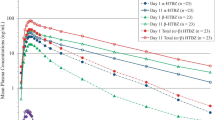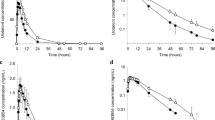Abstract
Objectives
Carbamazepine (CBZ) undergoes biotransformation by CYP3A4 and CYP2C8, and glucuronide conjugation. There has been no clear demonstration to reveal the role of glucuronidation in the disposition of CBZ. We evaluated the effect of probenecid, a UDP-glucuronosyltransferase inhibitor, on the pharmacokinetics of CBZ in humans.
Methods
In a randomized, open-label, two-way crossover study, ten healthy male subjects were treated twice daily for 10 days with 500 mg probenecid or with a matched placebo. On day 6, a single dose of 200 mg CBZ was administered orally. Concentrations of CBZ and CBZ 10,11-epoxide (CBZ-E) in plasma and urine were measured.
Results
Probenecid decreased the area under the plasma concentration–time curve (AUC) of CBZ from 1253.9 μmol h/l to 1020.7 μmol h/l (P<0.001) while increasing that of CBZ-E from 137.6 μmol h/l to 183.5 μmol h/l (P=0.033). The oral clearance of CBZ was increased by probenecid by 26% (90% confidence interval, 17–34%; P<0.001). Probenecid increased the AUC ratio of CBZ-E/CBZ from 0.11 to 0.16 (P<0.001). However, probenecid had minimal effect on the recovery of the conjugated and free forms of CBZ and CBZ-E in urine.
Conclusion
Although probenecid showed a minimal effect on the glucuronidation of CBZ and CBZ-E, it increased CBZ biotransformation to CBZ-E, most likely reflecting the induction of CYP3A4 and CYP2C8 activities, in humans. These results demonstrate that glucuronide conjugation plays a minor role in the metabolism of CBZ and CBZ-E in humans, and that probenecid has an inducing effect on the disposition of CBZ.


Similar content being viewed by others
References
Beghi E, Perucca E (1995) The management of epilepsy in the 1990s: acquisitions, uncertainties and priorities for future research. Drugs 49:680–694
Beghi E (2002) Carbamazepine: clinical efficacy and use in other neurological disorders. In: Levy R, Mattson R, Meldrum B et al (eds) Antiepileptic drugs, 5th edn. Lippincott Williams& Wilkins, Philadelphia, pp273–277
Trimble MR (2002) Carbamazepine: clinical efficacy and use in psychiatric disorders. In: Levy R, Mattson R, Meldrum B et al (eds) Antiepileptic drugs, 5th edn. Lippincott Williams& Wilkins, Philadelphia, pp278–284
Ernst CL, Goldberg JF (2003) Antidepressant properties of anticonvulsant drugs for bipolar disorder. J Clin Psychopharmacol 23:182–192
Eichelbaum M, Tomson T, Tybring G, Bertilsson L (1985) Carbamazepine metabolism in man. Induction and pharmacogenetic aspects. Clin Pharmacokinet 10:80–90
Kerr BM, Thummel KE, Wurden CJ, Klein SM, Kroetz DL, Gonzalez FJ, Levy RH (1994) Human liver carbamazepine metabolism: role of CYP3A4 and CYP2C8 in 10,11-epoxide formation. Biochem Pharmacol 47:1969–1979
Mather GG, Levy RH (2000) Anticonvulsants. In: Levy RH, Thummel KE, Trager WF, Hansten PD, Eichelbaum M (eds) Metabolic drug interactions. Lippincott Williams& Wilkins, Philadelphia
Maggs JL, Pirmohamed M, Kitteringham NR, Park BK (2002) Characterization of the metabolites of carbamazepine in patient urine by liquid chromatography/mass spectrometry. Drug Metab Dispos 30:1170–1179
Bauer JE, Gerber N, Lynn RK, Smith RG, Thompson RM (1976) A new N-glucuronide metabolite of carbamazepine. Experientia 32:1032–1033
Spina E, Pisani F, Perucca E (1996) Clinically significant pharmacokinetic drug interactions with carbamazepine. An update. Clin Pharmacokinet 31:198–214
Baciewicz AM (1986) Carbamazepine drug interactions. Ther Drug Monit 8:305–317
Rambeck B, Specht U, Wolf P (1996) Pharmacokinetic interactions of the new antiepileptic drugs. Clin Pharmacokinet 31:309–324
Levy RH, Koch KM (1982) Drug interactions with valproate. Drugs 24:543–556
Yu HY, Shen YZ (2002) Concentration-dependent disposition of glucuronide metabolite of valproate. J Pharm Pharmacol 54:633–639
Bernus I, Dickinson RG, Hooper WD, Eadie MJ (1997) The mechanism of the carbamazepine–valproate interaction in humans. Br J Clin Pharmacol 44:21–27
Staines AG, Coughtrie MW, Burchell B (2004) N-glucuronidation of carbamazepine in human tissues is mediated by UGT2B7. J Pharmacol Exp Ther 311:1131–1137
Miners JO, Mackenzie PI (1991) Drug glucuronidation in humans. Pharmacol Ther 51:347–369
Uchaipichat V, Mackenzie PI, Guo XH, Gardner-Stephen D, Galetin A, Houston JB, Miners JO (2004) Human UDP-glucuronosyltransferases: isoform selectivity and kinetics of 4-methylumbelliferone and 1-naphthol glucuronidation, effects of organic solvents, and inhibition by diclofenac and probenecid. Drug Metab Dispos 32:413–423
Abernethy DR, Greenblatt DJ, Ameer B, Shader RI (1985) Probenecid impairment of acetaminophen and lorazepam clearance: direct inhibition of ether glucuronide formation. J Pharmacol Exp Ther 234:345–349
Dalton MJ, Powell JR, Messenheimer JA Jr (1985) Ranitidine does not alter single-dose carbamazepine pharmacokinetics in healthy adults. Drug Intell Clin Pharm 19:941–944
Elyas AA, Ratnaraj N, Goldberg VD, Lascelles PT (1982) Routine monitoring of carbamazepine and carbamazepine-10,11-epoxide in plasma by high-performance liquid chromatography using 10-methoxycarbamazepine as internal standard. J Chromatogr 231:93–101
So EL, Ruggles KH, Cascino GD, Ahmann PA, Weatherford KW (1994) Seizure exacerbation and status epilepticus related to carbamazepine-10,11-epoxide. Ann Neurol 35:743–746
Burstein AH, Horton RL, Dunn T, Alfaro RM, Piscitelli SC, Theodore W (2000) Lack of effect of St John’s Wort on carbamazepine pharmacokinetics in healthy volunteers. Clin Pharmacol Ther 68:605–612
Fitzgerald BJ, Okos AJ (2002) Elevation of carbamazepine-10,11-epoxide by quetiapine. Pharmacotherapy 22:1500–1503
Bertilsson L, Tomson T (1986) Clinical pharmacokinetics and pharmacological effects of carbamazepine and carbamazepine-10,11-epoxide. An update. Clin Pharmacokinet 11:177–198
Smith DA (2000) Induction and drug development. Eur J Pharm Sci 11:185–189
Potschka H, Fedrowitz M, Loscher W (2001) P-glycoprotein and multidrug resistance-associated protein are involved in the regulation of extracellular levels of the major antiepileptic drug carbamazepine in the brain. Neuroreport 12:3557–3560
Potschka H, Fedrowitz M, Loscher W (2003) Multidrug resistance protein MRP2 contributes to blood–brain barrier function and restricts antiepileptic drug activity. J Pharmacol Exp Ther 306:124–131
Gerk PM, Vore M (2002) Regulation of expression of the multidrug resistance-associated protein 2 (MRP2) and its role in drug disposition. J Pharmacol Exp Ther 302:407–415
Oude Elferink RP, Meijer DK, Kuipers F, Jansen PL, Groen AK, Groothuis GM (1995) Hepatobiliary secretion of organic compounds; molecular mechanisms of membrane transport. Biochim Biophys Acta 1241:215–268
Chan LM, Lowes S, Hirst BH (2004) The ABCs of drug transport in intestine and liver: efflux proteins limiting drug absorption and bioavailability. Eur J Pharm Sci 21:25–51
Potschka H, Fedrowitz M, Loscher W (2003) Brain access and anticonvulsant efficacy of carbamazepine, lamotrigine, and felbamate in ABCC2/MRP2-deficient TR—rats. Epilepsia 44:1479–486
Author information
Authors and Affiliations
Corresponding author
Rights and permissions
About this article
Cite this article
Kim, KA., Oh, S.O., Park, PW. et al. Effect of probenecid on the pharmacokinetics of carbamazepine in healthy subjects. Eur J Clin Pharmacol 61, 275–280 (2005). https://doi.org/10.1007/s00228-005-0940-7
Received:
Accepted:
Published:
Issue Date:
DOI: https://doi.org/10.1007/s00228-005-0940-7




